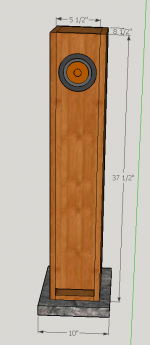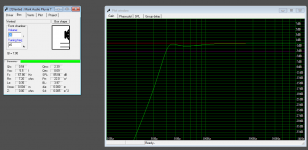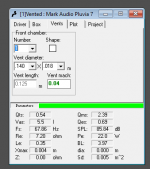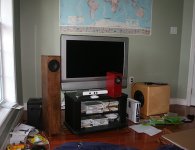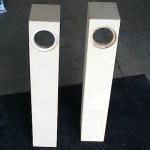Not at all. The intention was always to give them away. I wanted to build a nice homemade setup for the in laws to enjoy primarily folk music. My excuse of "breaking them in" was getting exposed as nonsense the longer I kept them 😈. I still have my other pluvia 7 build in my breakfast nook that I enjoy everyday ☺️
Thinking of doing another build for a friend, going to try my own design this time. Would anyone here sanity check this?
Small ported tower
Outer dimensions: 7" W * 8-1/2" D * 37-1/2" H
Inner Dimensions: 5-1/2" W * 7" D * 36" H
Inner Volume: 1386 inch^3, 22.7 litres. Estimate 20 liters to account for driver, bracing, port.
Tuning Frequency: 45 Hz
Slot Port: 5-1/2" W x 3/4" H (picture shows 1", that will be adjusted) x 5" long (4-1/4" shelf + 3/4" material thickness)
Small ported tower
Outer dimensions: 7" W * 8-1/2" D * 37-1/2" H
Inner Dimensions: 5-1/2" W * 7" D * 36" H
Inner Volume: 1386 inch^3, 22.7 litres. Estimate 20 liters to account for driver, bracing, port.
Tuning Frequency: 45 Hz
Slot Port: 5-1/2" W x 3/4" H (picture shows 1", that will be adjusted) x 5" long (4-1/4" shelf + 3/4" material thickness)
Attachments
Last edited:
Would anyone here sanity check this?
Given the aspect ratio this is not a bass reflex but a mass-loaded transmission line. Your BR sim will not accurately model this box.
dave
If you're not in a hurry to start building the enclosure, I could model it in MJK's MLTL mathcad worksheet and report back with results.

I'll do the same with LATL. Just for fun.
Eric
Wiggle - there may already be a "Pensil" variant vetted by Scott or Dave for this driver that would be very similar in format, if not dimensions to your sketch
edit: if I'd taken the time to read through this thread, I can see it here:
http://www.diyaudio.com/forums/full-range/284525-new-mark-audio-pluvia-seven.html#post4563602
It's deeper than I would have thought, but all the math is done, and I've yet to be underwhelmed by any of the over dozen of Scott's designs I've built.
edit: if I'd taken the time to read through this thread, I can see it here:
http://www.diyaudio.com/forums/full-range/284525-new-mark-audio-pluvia-seven.html#post4563602
It's deeper than I would have thought, but all the math is done, and I've yet to be underwhelmed by any of the over dozen of Scott's designs I've built.
Last edited:
a variant of Compact Floorstander tuned for this driver
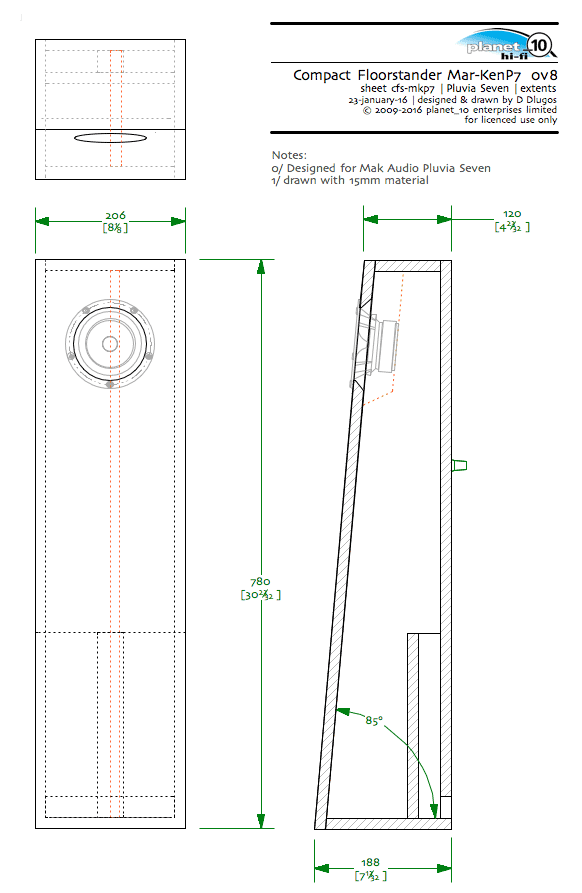
Provisionally called Mar-Ken i want to change the name to Plu-Ken so these are Compact Floorstander Plu-Ken7.
dave
Thinking of doing another build for a friend, going to try my own design this time. Would anyone here sanity check this?
Small ported tower
Outer dimensions: 7" W * 8-1/2" D * 37-1/2" H
Inner Dimensions: 5-1/2" W * 7" D * 36" H
Inner Volume: 1386 inch^3, 22.7 litres. Estimate 20 liters to account for driver, bracing, port.
Tuning Frequency: 45 Hz
Slot Port: 5-1/2" W x 3/4" H (picture shows 1", that will be adjusted) x 5" long (4-1/4" shelf + 3/4" material thickness)
Using these dimension and the Pluvia 7 TS parameters, with the LATL model, gave this result, which looks pretty good to me. Please note, this is the "unstuffed" result, so the spikes at the higher frequencies will be largely eliminated, if you stuff it correctly. Also note, I place the driver at about 16 inches from the top, which eliminates the resonance that occurs at just over 200 Hz. Others may suggest it be placed at closer to 8 inches. Actually anywhere between the two is probably reasonable.
An externally hosted image should be here but it was not working when we last tested it.
That said, I think you might actually get a slight improvement by reducing the depth by about 2 inches, so the cross section is 5.5 x 5.5 (area 30.35 in2).
Making that change (and with the driver at 15.75 inches), I got the result below, in which the low frequency peak in the system response is more subtle and the slope of the system response is a little flatter in the 60-200 Hz range. The smaller volume also reduced the port velocity, which might also be a slight improvement. If there is a downside it's that the tuning is increased by about 4 Hz. But either one looks pretty good to me.
An externally hosted image should be here but it was not working when we last tested it.
Hope that helps.
Eric
Thanks Dave, I was also interested in that build but admittedly wanted something I had a hand in designing.
Provisionally called Mar-Ken i want to change the name to Plu-Ken so these are Compact Floorstander Plu-Ken7.
dave
Thanks Eric the help is appreciated. So that would be a 5" x 5" slot port, is that 2" referring to the shelf length only or would it be that total (1.25 + baffle)?Using these dimension and the Pluvia 7 TS parameters, with the LATL model, gave this result, which looks pretty good to me. Please note, this is the "unstuffed" result, so the spikes at the higher frequencies will be largely eliminated, if you stuff it correctly. Also note, I place the driver at about 16 inches from the top, which eliminates the resonance that occurs at just over 200 Hz. Others may suggest it be placed at closer to 8 inches. Actually anywhere between the two is probably reasonable.

That said, I think you might actually get a slight improvement by reducing the depth by about 2 inches, so the cross section is 5.5 x 5.5 (area 30.35 in2).
Making that change (and with the driver at 15.75 inches), I got the result below, in which the low frequency peak in the system response is more subtle and the slope of the system response is a little flatter in the 60-200 Hz range. The smaller volume also reduced the port velocity, which might also be a slight improvement. If there is a downside it's that the tuning is increased by about 4 Hz. But either one looks pretty good to me.

Hope that helps.
Eric
Would there be any major detriment to going close to the top, like 6" from center of driver to top of enclosure?
Thanks Eric the help is appreciated. So that would be a 5" x 5" slot port, is that 2" referring to the shelf length only or would it be that total (1.25 + baffle)?
Would there be any major detriment to going close to the top, like 6" from center of driver to top of enclosure?
Regarding the port, I did not change it at all in the two models. I assumed a port cross section of 5.5 x 0.75 (4.125 in2) with a length of 5 inches. I did not draw out the enclosure to see what you would have to do to achieve that with the reduced depth, but it seems possible that you could. The change I showed was due only to a change in the modeled cross section of the main line.
Regarding the effect of driver position, probably you should ask someone else, because my opinion is not mainstream! But I won't let that stop me from telling you what I think, and why. The main effect will be the generation of a large resonance peak at a bit over 300 Hz, as shown in the sim below:
An externally hosted image should be here but it was not working when we last tested it.
Now, it is true that you can use stuffing to reduce even a 300 Hz peak. However, peaks at lower frequencies require more stuffing to subdue than ones at higher frequencies. And the more stuffing you add, the more you start reducing the bass output at 40-100 Hz. But the bass output in that region is the whole point of the cabinet design!
I also don't care for the high terminus output in the 800-1500 Hz region, but I'm not sure if that's a real issue or not.
All that said, I'll remind you that my experience is very limited. That doesn't make me think I'm wrong. But it does make me aware that I might be!
Eric
The main effect will be the generation of a large resonance peak at a bit over 300 Hz
Eric
Oops again, that should read, "peak at a bit over 200 Hz" not 300Hz.
Eric
Member
Joined 2009
Paid Member
I like these MLTL speakers - I make a pair for a different driver but the general idea is vey similar: http://www.diyaudio.com/forums/full-range/220047-martello-2-mini-tower-single-2-x-4-a.html
My priority was to make the speaker slim and small with a traditional upright appearance - my sister was getting rid of old B&W speakers because they were too big ! (they're now in my basement). These Martello-2 speakers are now what I use with an old Marantz receiver for listening to vinyl.
Dave mentions the suitability of the Pluvia in that thread.
In the photo, the Martello-1 is the little red speaker, the big sub is also my design ( a push-push design ) and the Martello-2 is the tall one.
My priority was to make the speaker slim and small with a traditional upright appearance - my sister was getting rid of old B&W speakers because they were too big ! (they're now in my basement). These Martello-2 speakers are now what I use with an old Marantz receiver for listening to vinyl.
Dave mentions the suitability of the Pluvia in that thread.
In the photo, the Martello-1 is the little red speaker, the big sub is also my design ( a push-push design ) and the Martello-2 is the tall one.
Attachments
Last edited:
- Status
- This old topic is closed. If you want to reopen this topic, contact a moderator using the "Report Post" button.
- Home
- Loudspeakers
- Full Range
- New Mark Audio Pluvia Seven
